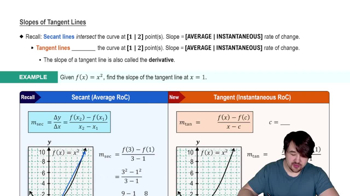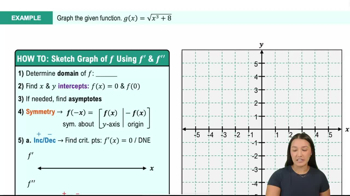Table of contents
- 0. Functions7h 52m
- Introduction to Functions16m
- Piecewise Functions10m
- Properties of Functions9m
- Common Functions1h 8m
- Transformations5m
- Combining Functions27m
- Exponent rules32m
- Exponential Functions28m
- Logarithmic Functions24m
- Properties of Logarithms34m
- Exponential & Logarithmic Equations35m
- Introduction to Trigonometric Functions38m
- Graphs of Trigonometric Functions44m
- Trigonometric Identities47m
- Inverse Trigonometric Functions48m
- 1. Limits and Continuity2h 2m
- 2. Intro to Derivatives1h 33m
- 3. Techniques of Differentiation3h 18m
- 4. Applications of Derivatives2h 38m
- 5. Graphical Applications of Derivatives6h 2m
- 6. Derivatives of Inverse, Exponential, & Logarithmic Functions2h 37m
- 7. Antiderivatives & Indefinite Integrals1h 26m
- 8. Definite Integrals4h 44m
- 9. Graphical Applications of Integrals2h 27m
- 10. Physics Applications of Integrals 2h 22m
5. Graphical Applications of Derivatives
Curve Sketching
Problem 4.2.40
Textbook Question
Mean Value Theorem and graphs Find all points on the interval (1,3) at which the slope of the tangent line equals the average rate of change of f on [1,3]. Reconcile your results with the Mean Value Theorem. <IMAGE>
 Verified step by step guidance
Verified step by step guidance1
First, understand the Mean Value Theorem (MVT): It states that for a continuous function f on the closed interval [a, b] that is differentiable on the open interval (a, b), there exists at least one point c in (a, b) such that the derivative at c, f'(c), is equal to the average rate of change of the function over [a, b].
Calculate the average rate of change of the function f on the interval [1, 3]. This is given by the formula: (f(3) - f(1)) / (3 - 1).
Find the derivative of the function, f'(x), which represents the slope of the tangent line at any point x.
Set the derivative f'(x) equal to the average rate of change calculated in step 2. Solve this equation to find the value(s) of x in the interval (1, 3) where the slope of the tangent line equals the average rate of change.
Verify that the solution(s) found in step 4 satisfy the conditions of the Mean Value Theorem: the function must be continuous on [1, 3] and differentiable on (1, 3). If these conditions are met, the solution(s) are valid according to the theorem.
 Verified video answer for a similar problem:
Verified video answer for a similar problem:This video solution was recommended by our tutors as helpful for the problem above
Video duration:
2mPlay a video:
Was this helpful?
Key Concepts
Here are the essential concepts you must grasp in order to answer the question correctly.
Mean Value Theorem
The Mean Value Theorem (MVT) states that if a function is continuous on a closed interval [a, b] and differentiable on the open interval (a, b), then there exists at least one point c in (a, b) where the derivative of the function at c equals the average rate of change of the function over [a, b]. This theorem is fundamental in connecting the behavior of a function to its derivative.
Recommended video:

Fundamental Theorem of Calculus Part 1
Average Rate of Change
The average rate of change of a function f over an interval [a, b] is calculated as (f(b) - f(a)) / (b - a). This value represents the slope of the secant line connecting the points (a, f(a)) and (b, f(b)). Understanding this concept is crucial for applying the Mean Value Theorem, as it provides the value that the derivative must equal at some point within the interval.
Recommended video:

Average Value of a Function
Tangent Line and Derivative
The slope of the tangent line to a function at a given point is represented by the derivative of the function at that point. This slope indicates the instantaneous rate of change of the function. In the context of the Mean Value Theorem, finding points where the tangent line's slope equals the average rate of change is essential for identifying the specific points c where the theorem holds true.
Recommended video:

Slopes of Tangent Lines

 11:41m
11:41mWatch next
Master Summary of Curve Sketching with a bite sized video explanation from Callie
Start learning




